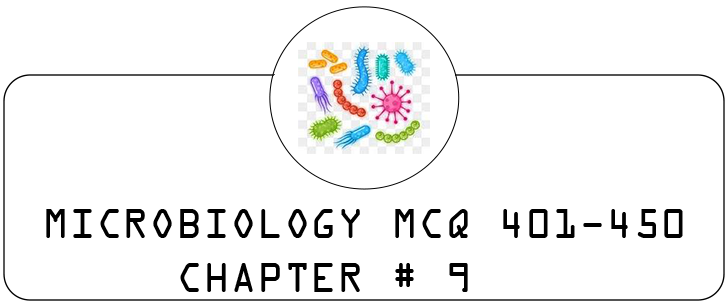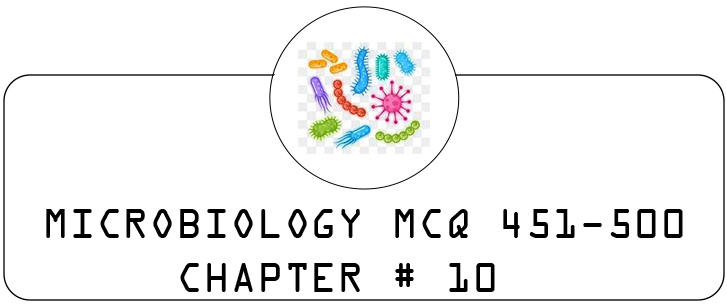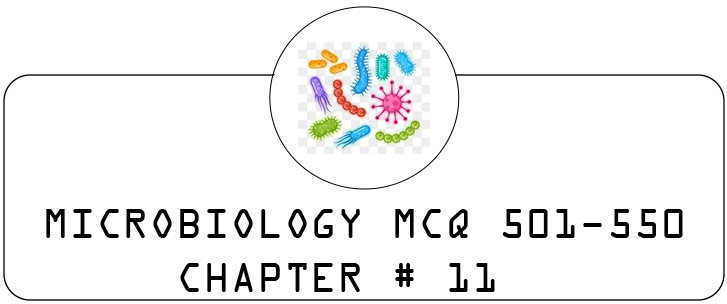351. Which of following mediates an initial response to viral infections by the innate immune system?
A. Complement components
B. T and B lymphocytes
C. Cytokines
D. Interferons ✅
A. Complement components
B. T and B lymphocytes
C. Cytokines
D. Interferons ✅
352. Which one is a messenger that mediates connection between the innate and adaptive immune systems?
A. Complement components
B. T and B lymphocytes
C. Cytokines ✅
D. Interferons
A. Complement components
B. T and B lymphocytes
C. Cytokines ✅
D. Interferons
353. _______ are resident macrophages present in CNS.
A. Kupffer cells
B. Alveolar cells
C. Microglial cells ✅
D. Langerhans
A. Kupffer cells
B. Alveolar cells
C. Microglial cells ✅
D. Langerhans
354. If you were a neutrophil recruited to an anaerobic site to kill such a bacterium, which of the following substances would you most likely use?
A. IL-12
B. Nitric oxide
C. Cathelicidin
D. Respiratory burst oxidase ✅
A. IL-12
B. Nitric oxide
C. Cathelicidin
D. Respiratory burst oxidase ✅
355. Which of the following is a “pattern recognition receptor”?
A. BCR
B. Interleukin-1 receptor
C. Mannose receptor ✅
D. Fc receptor
A. BCR
B. Interleukin-1 receptor
C. Mannose receptor ✅
D. Fc receptor
356. A molecule that reacts with specific antibody but is not immunogenic by itself is called:
A. Carrier
B. Antigen
C. Hapten ✅
D. Immunogen
A. Carrier
B. Antigen
C. Hapten ✅
D. Immunogen
357. What type of vaccine is used to protect vulnerable individuals from influenza?
A. It is an example of a subunit vaccine ✅
B. It is an example of a live attenuated vaccine
C. It is an example of passive immunization
D. It is an example of a recombinant vaccine
A. It is an example of a subunit vaccine ✅
B. It is an example of a live attenuated vaccine
C. It is an example of passive immunization
D. It is an example of a recombinant vaccine
358. The initial complement component that is bound by complement-fixing antibodies is:
A. C1q ✅
B. C1s
C. C3b
D. C5a
A. C1q ✅
B. C1s
C. C3b
D. C5a
359. The _____ immune system uses ____ as well as antigen recognition molecules and the ______ immune system uses ______ as well as molecules (e.g., interferons).
A. Adaptive; Phagocytes; Innate; Lymphocytes
B. Adaptive; Lymphocytes; Innate; Phagocytes ✅
C. Innate; Phagocytes; Adaptive; Lymphocytes
D. Innate; Lymphocytes; Adaptive; Phagocytes
A. Adaptive; Phagocytes; Innate; Lymphocytes
B. Adaptive; Lymphocytes; Innate; Phagocytes ✅
C. Innate; Phagocytes; Adaptive; Lymphocytes
D. Innate; Lymphocytes; Adaptive; Phagocytes
360. Which of the following immune cells uses antibodies as membrane bound receptors?
A. T-helper cell
B. Cytotoxic T-cell
C. B-lymphocyte ✅
D. Macrophage
A. T-helper cell
B. Cytotoxic T-cell
C. B-lymphocyte ✅
D. Macrophage
361. Which of the complement pathway among various pathways will activate first?
A. Classical pathway
B. Alternate pathway ✅
C. Lectin pathway
D. All act simultaneously
A. Classical pathway
B. Alternate pathway ✅
C. Lectin pathway
D. All act simultaneously
362. Which one of the following is NOT usually included in physical barriers?
A. Sweat glands
B. Salivary glands
C. Mucous membranes
D. Skin ✅
A. Sweat glands
B. Salivary glands
C. Mucous membranes
D. Skin ✅
363. The use of live vaccines usually provides:
A. Shorter immunity
B. More effective immunity ✅
C. No side effects
D. None of the above
A. Shorter immunity
B. More effective immunity ✅
C. No side effects
D. None of the above
364. Gram-positive bacteria retain crystal violet stain due to:
A. Thick peptidoglycan layer ✅
B. Thin peptidoglycan layer
C. Lipopolysaccharide layer
D. None of the above
A. Thick peptidoglycan layer ✅
B. Thin peptidoglycan layer
C. Lipopolysaccharide layer
D. None of the above
365. The predominant immunoglobulin found in the blood is:
A. IgA
B. IgM
C. IgG ✅
D. IgE
A. IgA
B. IgM
C. IgG ✅
D. IgE
366. Which of the following is NOT a property of viruses?
A. They can reproduce independently ✅
B. They contain nucleic acid
C. They are obligate intracellular parasites
D. They can evolve
A. They can reproduce independently ✅
B. They contain nucleic acid
C. They are obligate intracellular parasites
D. They can evolve
367. Which type of bacteria can live without oxygen?
A. Aerobes
B. Anaerobes ✅
C. Microaerophiles
D. Capnophiles
A. Aerobes
B. Anaerobes ✅
C. Microaerophiles
D. Capnophiles
368. A bacterium with a spherical shape is referred to as:
A. Cocci ✅
B. Bacilli
C. Spirilla
D. Vibrio
A. Cocci ✅
B. Bacilli
C. Spirilla
D. Vibrio
369. Which of the following is NOT a Gram-positive bacterium?
A. Staphylococcus
B. Streptococcus
C. Bacillus
D. Escherichia ✅
A. Staphylococcus
B. Streptococcus
C. Bacillus
D. Escherichia ✅
370. What is the role of the capsule in bacteria?
A. Protection against phagocytosis ✅
B. Nutrient absorption
C. Energy production
D. DNA replication
A. Protection against phagocytosis ✅
B. Nutrient absorption
C. Energy production
D. DNA replication
371. Which of the following is a common vector for Lyme disease?
A. Fleas
B. Ticks ✅
C. Mosquitoes
D. Lice
A. Fleas
B. Ticks ✅
C. Mosquitoes
D. Lice
372. Antibodies are produced by which type of cells?
A. T-cells
B. B-cells ✅
C. Macrophages
D. Dendritic cells
A. T-cells
B. B-cells ✅
C. Macrophages
D. Dendritic cells
373. The most common cause of bacterial pneumonia in adults is:
A. Streptococcus pneumoniae ✅
B. Staphylococcus aureus
C. Klebsiella pneumoniae
D. Mycoplasma pneumoniae
A. Streptococcus pneumoniae ✅
B. Staphylococcus aureus
C. Klebsiella pneumoniae
D. Mycoplasma pneumoniae
374. Which of the following is NOT a characteristic of viruses?
A. Contain genetic material
B. Capable of metabolism ✅
C. Obligate intracellular parasites
D. Can mutate
A. Contain genetic material
B. Capable of metabolism ✅
C. Obligate intracellular parasites
D. Can mutate
375. Which type of immunity is produced by the body after exposure to a pathogen?
A. Passive immunity
B. Active immunity ✅
C. Innate immunity
D. Natural immunity
A. Passive immunity
B. Active immunity ✅
C. Innate immunity
D. Natural immunity
376. The most effective way to sterilize heat-sensitive materials is:
A. Boiling
B. Autoclaving
C. Filtration ✅
D. Incineration
A. Boiling
B. Autoclaving
C. Filtration ✅
D. Incineration
377. Which of the following bacteria is known for causing food poisoning?
A. Salmonella ✅
B. E. coli
C. Listeria
D. Campylobacter
A. Salmonella ✅
B. E. coli
C. Listeria
D. Campylobacter
378. A Gram-negative bacterium typically has:
A. A thick peptidoglycan layer
B. An outer membrane ✅
C. Teichoic acids
D. No capsule
A. A thick peptidoglycan layer
B. An outer membrane ✅
C. Teichoic acids
D. No capsule
379. The major role of the immune system is to:
A. Produce energy
B. Protect the body from pathogens ✅
C. Regulate blood pressure
D. Maintain homeostasis
A. Produce energy
B. Protect the body from pathogens ✅
C. Regulate blood pressure
D. Maintain homeostasis
380. The function of macrophages in the immune system is to:
A. Produce antibodies
B. Phagocytize pathogens ✅
C. Present antigens
D. All of the above
A. Produce antibodies
B. Phagocytize pathogens ✅
C. Present antigens
D. All of the above
381. The component of the immune system that can directly kill infected host cells is:
A. T-cells ✅
B. B-cells
C. Macrophages
D. Antibodies
A. T-cells ✅
B. B-cells
C. Macrophages
D. Antibodies
382. Which of the following is a characteristic of the adaptive immune response?
A. Specificity ✅
B. Immediate response
C. Non-specificity
D. All of the above
A. Specificity ✅
B. Immediate response
C. Non-specificity
D. All of the above
383. Which organism is known to cause malaria?
A. Toxoplasma gondii
B. Plasmodium ✅
C. Giardia lamblia
D. Trichomonas vaginalis
A. Toxoplasma gondii
B. Plasmodium ✅
C. Giardia lamblia
D. Trichomonas vaginalis
384. Which of the following is NOT a method of sterilization?
A. Autoclaving
B. Filtration
C. Dry heat
D. Boiling ✅
A. Autoclaving
B. Filtration
C. Dry heat
D. Boiling ✅
385. The most important component of the innate immune system is:
A. Antibodies
B. Phagocytes ✅
C. T-cells
D. B-cells
A. Antibodies
B. Phagocytes ✅
C. T-cells
D. B-cells
386. The main function of dendritic cells is to:
A. Produce antibodies
B. Present antigens ✅
C. Phagocytize pathogens
D. Regulate T-cell activation
A. Produce antibodies
B. Present antigens ✅
C. Phagocytize pathogens
D. Regulate T-cell activation
387. The most common vector-borne disease in the United States is:
A. Malaria
B. Lyme disease ✅
C. Dengue fever
D. Zika virus
A. Malaria
B. Lyme disease ✅
C. Dengue fever
D. Zika virus
388. Which of the following is NOT a common bacterial pathogen?
A. E. coli
B. Streptococcus
C. Influenza ✅
D. Salmonella
A. E. coli
B. Streptococcus
C. Influenza ✅
D. Salmonella
389. The most effective disinfectant against viruses is:
A. Alcohol ✅
B. Bleach
C. Hydrogen peroxide
D. Formaldehyde
A. Alcohol ✅
B. Bleach
C. Hydrogen peroxide
D. Formaldehyde
390. The presence of which of the following indicates that a person has been infected with a pathogen?
A. Antigen ✅
B. Antibody
C. Toxin
D. None of the above
A. Antigen ✅
B. Antibody
C. Toxin
D. None of the above
391. The primary role of interferons is to:
A. Directly kill pathogens
B. Signal other cells to defend against viruses ✅
C. Produce antibodies
D. Activate complement
A. Directly kill pathogens
B. Signal other cells to defend against viruses ✅
C. Produce antibodies
D. Activate complement
392. The most common source of nosocomial infections is:
A. Contaminated medical equipment ✅
B. Patient’s own flora
C. Airborne transmission
D. Vector transmission
A. Contaminated medical equipment ✅
B. Patient’s own flora
C. Airborne transmission
D. Vector transmission
393. A common route of transmission for HIV is:
A. Airborne
B. Blood and sexual contact ✅
C. Foodborne
D. Fomite
A. Airborne
B. Blood and sexual contact ✅
C. Foodborne
D. Fomite
394. The most serious complication of untreated streptococcal pharyngitis is:
A. Scarlet fever
B. Rheumatic fever ✅
C. Glomerulonephritis
D. None of the above
A. Scarlet fever
B. Rheumatic fever ✅
C. Glomerulonephritis
D. None of the above
395. Which of following is most resistant to antiseptics?
A. Spore ✅
B. Prion
C. Cyst
D. Fungus
A. Spore ✅
B. Prion
C. Cyst
D. Fungus
396. Which of the following is enrichment media?
A. Selenite F broth ✅
B. Chocolate media
C. Egg media
D. Meat extract media
A. Selenite F broth ✅
B. Chocolate media
C. Egg media
D. Meat extract media
397. Lyophilization is:
A. Holding at 72° C for 15 seconds
B. Competitive inhibition
C. Freeze-drying ✅
D. Sterility testing
A. Holding at 72° C for 15 seconds
B. Competitive inhibition
C. Freeze-drying ✅
D. Sterility testing
398. Gene mutation occurs at the time of:
A. DNA repair
B. DNA replication ✅
C. Translation
D. RNA transcription
A. DNA repair
B. DNA replication ✅
C. Translation
D. RNA transcription
399. All of the following can be part of innate immune responses EXCEPT:
A. B-cells ✅
B. Alternative pathway of complement system
C. Natural killer cells
D. Macrophages
A. B-cells ✅
B. Alternative pathway of complement system
C. Natural killer cells
D. Macrophages
400. The cellular immune response is mediated by:
A. B cells
B. T cell ✅
C. B & T cells
D. Endothelial cells
A. B cells
B. T cell ✅
C. B & T cells
D. Endothelial cells





